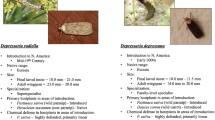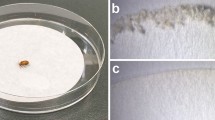Summary
Two South American polyphagous leaf beetles,Diabrotica speciosa andCerotoma arcuata, selectively accumulated the bitter tasting compound 23,24-dihydrocucurbitacin D in their body after ingesting root tissues of cucurbit plants. Similarly, three Asian Cucurbitaceae-feeding specialists in the genusAulacophora were found to sequester the same compound. Cucurbitacin analogs were shown to deter feeding by a bird predator, indicating an allomonal role for these compounds in cucurbitacin-associated chrysomelid leaf beetles both of New and Old Worlds. The strong affinity to cucurbitacins, selective sequestration of the analogs and consequent protection from predators suggested an ecological adaptation mechanism developed in common among these two geographically isolated subtribes in the Luperini.
Similar content being viewed by others
References
Audier HE, Das DC (1966) Mass spectrometry of tetracyclic triterpenes. Part I — The cucurbitacin group. Tetrahedron Lett: 2205–2210
Boppré M (1978) Chemical communication, plant relationships, and mimicry in the evolution of danaid butterflies. Entomol exp appl 24:264–277
Boppré M (1984) Redefining “pharmacophagy”. J Chem Ecol 10:1151–1154
Boppré M (1990) Lepidoptera and pyrrolizidine alkaloids: exemplification of complexity in chemical ecology. J Chem Ecol 16:165–185
Brown KS (1984) Adult-obtained pyrrolizidine alkaloids defend ithomiine butterflies against a spider predator. Nature 309:707–709
Carroll CR, Hoffman CA (1980) Chemical feeding deterrent mobilized in response to insect herbivory and counteradaptation byEpilachna tredecimnotata. Science 209:414–416
Chambliss OL, Jones CM (1966a) Cucurbitacins: specific insect attractants in Cucurbitaceae. Science 153:1392–1393
Chambliss OL, Jones CM (1966b) Chemical and genetic basis for insect resistance in cucurbits. Proc Am Soc Hort Sci 89:394–405
Contardi HG (1939) Estudios geneticos enCucurbita. Physis L8:331–347
DaCosta CP, Jones CM (1971) Cucumber beetle resistance and mite susceptibility controlled by the bitter gene inCucumis sativa L. Science 172:1145–1146
David A, Vallance DK (1955) Bitter principles of Cucurbitaceae. J Pharm Pharmacol 7:295–296
Doskotch RW, Hufford CD (1970) Hexanor-cucurbitacin D, a degraded cucurbitacin fromBegonia tuberhybrida var.alba. Canadian J Chem 48:1787–1788
Ferguson JE, Metcalf RL (1985) Cucurbitacins: plant derived defense compounds for diabroticites (Coleoptera: Chrysomelidae). J Chem Ecol 11:311–318
Ferguson JE, Metcalf RL, Fisher DC (1985) Distribution and fate of cucurbitacin B in five species of diabroticites. J Chem Ecol 11:1307–1321
Gould F, Massey A (1984) Cucurbitacins and predation of the spotted cucumber beetle,Diabrotica undecimpunctata howardi. Entomol exp appl 36:273–278
Howe WL, Sanborn JR, Rhodes AM (1976) Western corn rootworm adult and spotted cucumber beetle associations withCucurbita and cucurbitacins. Environ Entomol 5:1043–1048
Lavie D, Glotter E (1971) The cucurbitacins, a group of tetracyclic triterpenes. Fortschr Chem Org Naturst 29:307–362
Metcalf RL (1979) Plants, Chemicals, and insects: some aspects of coevolution. Bull Entomol Soc Am 25:30–35
Metcalf RL (1985) Plant kairomones and insect pest control. Illinois Nat Hist Survey Bull 33:175–198
Metcalf RL (1986) Coevolutionary adaptations of rootworm beetles (Coleoptera, Chrysomelidae) to cucurbitacins. J Chem Ecol 12:1109–1124
Metcalf RL, Rhodes AM, Metcalf RA, Ferguson JE, Metcalf RE, Lu PY (1982) Cucurbitacin contents and Diabroticite (Coleoptera: Chrysomelidae) feeding uponCucurbita spp. Environ Entomol 11:931–937
Nishida R, Fukami H, Tanaka Y, Magalhães BP, Yokoyama M, Blumenschein A (1986) Isolation of feeding stimulants of Brazilian leaf beetles (Diabrotica speciosa andCerotoma arcuata) from the root ofCeratosanthes hilariana. Agric Biol Chem 50:2831–2836
Nishida R, Fukami H (1990) Sequestration of distasteful compounds by some pharmacophagous insects. J Chem Ecol 16:151–164
Nishida R, Kim CS, Fukami H, Irie R (1991) IdeamineN-oxides: pyrrolizidine alkaloids sequestered by the danaine butterfly,Idea leuconoe. Agric Biol Chem 1787–1792
Rhodes AM, Metcalf RL, Metcalf ER (1980) Diabroticite beetle responses to cucurbitacin kairomones inCucurbita hybrids. J Am Soc Horti Sci 105:838–842
Shinha AK, Krishna SS (1969) Feeding ofAulacophora foveicollis on cucurbitacin. J Econ Ent 62:512–513
Shinha AK, Krishna SS (1970) Further studies on the feeding behavior ofAulacophora foveicollis on cucurbitacin. J Econ Ent 63:333–334
Smith RF (1966) Distributional patterns of selected western North American insects: the distribution of diabroticites in western North America. Ent Soc Am Bull 17:108–110
Tallamy DW (1985) Squash beetle feeding behavior: an adaptation against induced cucurbit defenses. Ecology 66:1574–1579
Trigo JR, Brown KS (1990) Variation of pyrrolizidine alkaloids in Ithomiinae: a comparative study between species feeding on Apocynaceae and Solanaceae. Chemoecology 1:22–29
Velde VV, Lavie D (1983)13C NMR spectroscopy of cucurbitacins. Tetrahedron 39:317–321
Whitaker TW, Bemis WP (1975) Origin and evolution of the cultivatedCucurbita. Torrey Bot Club Bull 102:362–368
Author information
Authors and Affiliations
Rights and permissions
About this article
Cite this article
Nishida, R., Yokoyama, M. & Fukami, H. Sequestration of cucurbitacin analogs by New and Old World chrysomelid leaf beetles in the tribe Luperini. Chemoecology 3, 19–24 (1992). https://doi.org/10.1007/BF01261452
Received:
Accepted:
Issue Date:
DOI: https://doi.org/10.1007/BF01261452




